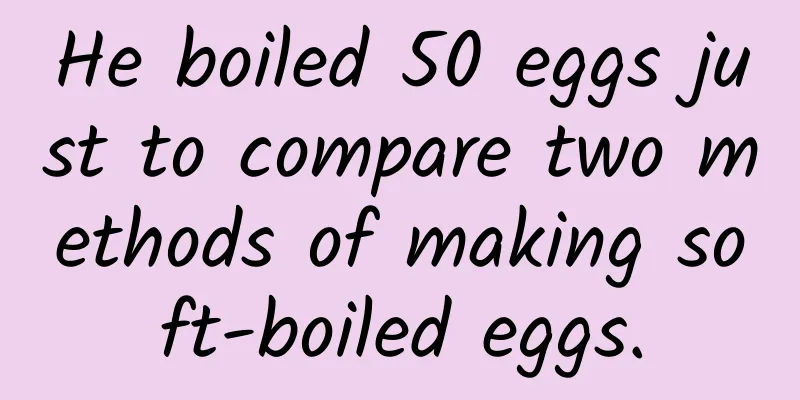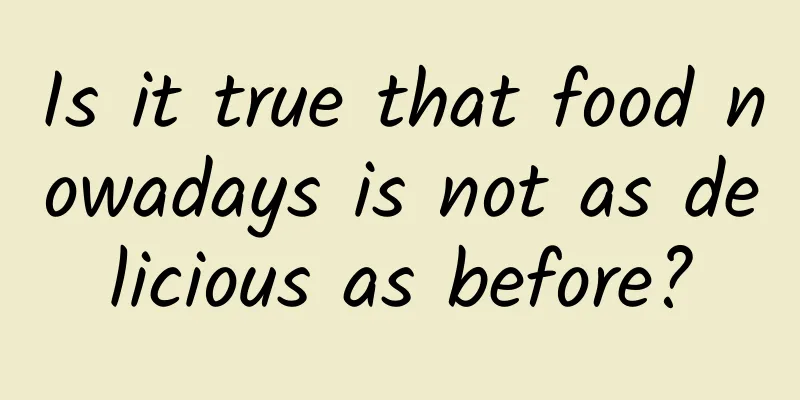He boiled 50 eggs just to compare two methods of making soft-boiled eggs.

|
Regarding boiling eggs, many cookbooks say this: It takes 3-6 minutes to boil a soft-boiled egg, 8-10 minutes to boil it thoroughly, and 6-8 minutes to boil an egg with a yolk that's somewhere in between. However, for those who want to cook a perfect soft-boiled egg, from a scientific point of view, the 3-8 minute window is too large, and many important parameters have not been determined: Does the size of the egg matter? Did you just take it out of the fridge or keep it at room temperature? Cook with boiling water or cold water? If you are cooking with cold water, should you start timing from the moment you turn on the fire or from the moment the water boils? Does the size of the pot, the amount of water, and the power of the stove affect the time? Image | http://blog.khymos.org/2011/04/18/perfect-egg-yolks/ If these questions really bother you, keep reading because we're going to give you the ultimate boiled egg formula. If you want to know the answer directly, please scroll to the end of this article! The Ultimate Hard-Boiled Egg Formula I was in high school when I first heard about the boiled egg formula and thought these people were so nerdy; many years later, I didn’t expect that I became one of them :) Thanks to Google and Peter Barham’s book The Science of Cooking, I found the most detailed formula for boiling an egg on the web: a mass-based formula provided by Dr Charles DH Williams, a lecturer in physics at the University of Exeter; he even has a website dedicated to boiling eggs, and gives the derivation of the formula. Parameters: Tegg = initial temperature of the egg (temperature units are all °C); Twater = water temperature; Tyolk = ideal temperature of the boundary between the egg white and the yolk; t = boiling time (unit: minutes); M = egg mass (unit: grams) If there is no condition to accurately weigh the mass of the egg, Peter Baham also gives a formula based on the circumference of the egg in the book "The Science of Cooking" (the circumference here refers to the circumference of the thickest part of the egg), which can be measured with a thin wire and a ruler: Parameter description: t = boiling egg time (unit: minutes); c = egg circumference (unit: centimeters) My colleagues at the University of Oslo also made a flash to demonstrate the Barham formula. Barham's formula gives the time for the center of the yolk to reach the desired temperature; Williams' gives the time for the yolk-white boundary to reach the ideal temperature. I did an experiment with 50 eggs. When the ideal yolk temperature was 63 °C and the water temperature was 100 °C, the times given by the two formulas were similar, but the variance of the perimeter formula was larger (see the figure below); when the yolk temperature was higher or the water temperature was lower, the time calculated according to the Williams formula was longer. Further experiments are needed to find out which of the two formulas is more scientific. Figure | http://blog.khymos.org/2009/04/09/towards-the-perfect-soft-boiled-egg/ The picture shows the cooking time calculated by the mass formula and the circumference formula for 50 eggs (arranged by mass) under the conditions of ideal yolk temperature of 63 °C, water temperature of 100 °C, and initial egg temperature of 4 °C. The circumference of an egg is actually not easy to measure, so the error is larger. Whether the egg is cooked properly depends mainly on the temperature of the egg white and the yolk. The egg white will begin to coagulate between 62-65 °C. At this temperature, the most temperature-sensitive protein in the egg white, ovotransferrin, begins to coagulate. It accounts for about 12% of the total weight of the egg white; while the protein ovalbumin, which accounts for 54% of the total weight of the egg white, will not begin to coagulate until it is above 80°C. The egg yolk begins to harden at about 65 °C and coagulates at about 70 °C. Further heating to about 80-90 °C, the soft-boiled egg becomes a regular white-boiled egg. The figure below shows the changes that occur in the yolk and egg white when cooking eggs using the Sous Vide method, and the table below summarizes these changes in words: At sea level, water boils at 100 °C. The higher the altitude, the lower the boiling point of water; generally speaking, the boiling temperature of water drops by 0.3 °C for every 100 meters of altitude increase; for more precise numbers, you can use this calculator. Finally, the initial temperature of eggs is generally 4 °C (from the refrigerator) or 20 °C (at room temperature). I calculated the boiling time for 50 eggs when the yolk temperature was 63 °C, the water temperature was 100 °C, and the initial egg temperature was 4 °C. In this way, knowing the mass or circumference of the egg, you can get the ideal boiling time by looking at the picture! Look at the picture to know the time, circumference on the left, mass on the right | http://blog.khymos.org/2009/04/09/towards-the-perfect-soft-boiled-egg/ However, the formula doesn’t work… Are eggs cooked according to this formula perfect? Actually...no. The problem with boiling eggs in boiling water is that even if the yolk reaches the ideal temperature, the temperature of the egg white cannot be controlled. If the water temperature is 95-100 °C, the egg white (at least the outermost part of the egg white) will also be 95-100 °C, and the egg white at this temperature will taste tough. So now our problem is to heat the egg yolk to 65 °C while not letting the egg white reach above 80 °C. What to do? Don't boil it in plain water, use sous vide. (Translator's note: Sous vide is a molecular cooking method, generally refers to heating vacuum-treated ingredients at a low temperature of about 60°C for a long time) The soufflé method only requires water bath heating, without the need for plastic bags or vacuum packaging. The following picture shows Douglas Baldwin's eggs cooked in the soufflé method for 75 minutes, heated to different temperatures from 57.8 to 66.7 ° C; the picture shows the changes in the yolk and white during the cooking process. Photograph: Douglas Baldwin; used with permission But the problem with eggs cooked using the Soufflé method is that they are "cooked in the pan": the yolk is set, but the white is still raw. If you don't have a Soufflé method water bath, you can also make your own hard-cooked eggs in the oven: preheat the oven to 70 °C, then heat a litre of water to 65-70 °C, put the eggs in the pot with water, cover with a lid, and put them in the oven for an hour; the oven thermometer is prone to error, so you need to use a separate thermometer to test the temperature. After a few tries, you will be able to make hard-cooked eggs. Although fun, this will make the egg white too watery. In my opinion, the perfect soft-boiled egg is about 70-80 °C for the egg white, 64 °C for the yolk-white border, and 60 °C for the center of the yolk. This can be cooked in a 75-80 °C waterbath in under an hour. Lazy soft-boiled eggs from various countries In fact, if you want to find a case of low-temperature boiled eggs, there are real examples: Japan's hot spring eggs - a basket of eggs is dipped into hot springs, and when eaten, they are beaten in kelp soup and topped with soy sauce and mirin. Due to the different temperatures of different hot springs, there are many types of hot spring eggs, but like cooking eggs using the soufflé method, the difficulty in making hot spring eggs lies in controlling the temperature; one way is to put the eggs on freshly cooked rice and then set the rice cooker to the keep warm mode. Hot spring egg. Image credit: Miya.m. License: GFDL, cc-by-sa-2.1-jp In Finland, some saunas have racks installed in the bathroom, and several layers of eggs are placed on the racks. The bottom layer is hard-boiled eggs, and the upper layer is soft-boiled eggs. However, since air transfers heat very slowly, the bathroom must be kept warm for a long time to achieve the effect of boiling eggs. If you put the eggs directly on the sauna stones, the eggshell will turn brown and have a nutty aroma; in Korea, such sauna eggs are also called Irwin eggs (Maekbanseok gyeran). Korean Sauna Egg | mykoreankitchen Can't you just tell me how to cook it? First, to achieve a soft-boiled egg, heat the eggs at a low temperature (around 60 degrees Celsius) for more than 60 minutes using the Soufflé method. The paper below even explains the time and temperature required for egg yolks to achieve different textures, from the consistency of condensed milk to the crumbly texture of cookie frosting. The time and temperature required to achieve the textures of different ingredients. From top to bottom: yeast paste, cookie icing, honey, mayonnaise, and condensed milk | Culinary Biophysics: on the Nature of the 6X °C Egg, figure 8, page 158. Next, if you want the texture of the egg white, you can soak the eggs in boiling water for 2 to 3 minutes after the sous vide method; if it is slightly cooler water, the time will be longer. The heat conduction of the uncoagulated egg white will probably increase the temperature of the egg yolk as well, but if you set the temperature slightly lower (just over 60 degrees Celsius) when heating in a water bath, you can avoid affecting the taste of the soft-boiled egg. Effect picture: soft-boiled eggs obtained by heating at different times at 63 degrees using the Shufei method | http://blog.khymos.org/2011/04/18/perfect-egg-yolks/ In a word: slow-cooking egg yolks at low temperature and solidifying egg whites in boiling water An AI I boiled dozens of eggs, but I don’t know if they were all eaten. By Martin Lersch Compiled by: Stellasun Editor: Fangorn The copyright of the translation belongs to Guokr and may not be reproduced without permission. If necessary, please contact [email protected] |
<<: How do bees train themselves to become "engineering students"? | Science Museum
>>: Why don't humans have green hair?
Recommend
@Shanghai Citizens: How to protect yourself after normalized prevention and control? Key actions to focus on →
At the Shanghai epidemic prevention and control p...
The sales of these 6 Korean SUVs have been pushed into a desperate situation.
In the automobile market, SUV is "undoubtedl...
Luoyang! Luoyang!
Luoyang A name that goes deep into the Chinese sp...
3 details for optimizing Tik Tok information flow advertising
The proportion of short videos in information flo...
Is Yinlong's 10 billion yuan new energy project going to fail? Too fast expansion is to blame
Recently, a seizure order issued by the Jiangsu P...
Better than the built-in file manager in Windows 11? Files App
I think everyone is using Windows' file explo...
How can a newbie on Douyin become a big V? Remember these 7 creative methods
When working in new media , choose a popular plat...
Luxi Tong - Aerobics for slimming that you can do at home
Once determined to lose weight, I believe many fr...
iPhone 6 will have three screen sizes?
It has been rumored that Apple's iPhone 6 wil...
The Qin Dynasty fell? Maybe it’s not entirely Qin Shi Huang’s fault…|BoLan Daily
The Qin Dynasty fell? Maybe it’s not entirely Qin...
My rhinos keep going missing, but this is good news
Editor’s Note: September 22 is World Rhino Day. T...
China Passenger Car Association: Analysis of the national passenger car market in February 2022
1. Review of the national passenger car market in...
From the fields to the people's tables, it is the "guardian knight" of pre-prepared meals
Have you ever eaten pre-prepared meals? Do you li...









